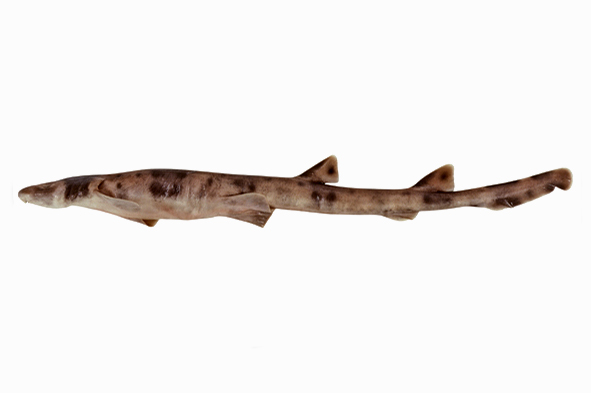Collar Carpetshark, Parascyllium collare Ramsay & Ogilby 1888
Other Names: Collared Carpet Shark, Collared Carpetshark, Collared Cat Shark, Collared Catshark

Collar Carpetshark, Parascyllium collare. Source: Australian National Fish Collection, CSIRO. License: CC By Attribution-NonCommercial
Summary:
A yellowish-brown to brown catshark with six broad bands around the body including a prominent dark brown band or collar behind the head, and large dark spots on the fins and in the pale interspaces.
Video of a Collared Carpetshark on deep patch reef NE of Bawley Point, New South Wales
Video of a Collared Carpetshark on deep patch reef NE of Bawley Point, New South Wales
Cite this page as:
Bray, D.J. 2025, Parascyllium collare in Fishes of Australia, accessed 06 Jul 2025, https://fishesofaustralia.net.au/home/species/3287
Collar Carpetshark, Parascyllium collare Ramsay & Ogilby 1888
More Info
|
Distribution |
Off Mooloolaba, southern Queensland, to Gabo Island, eastern Victoria, including Tasmania. Inhabits offshore rocky areas on the continental shelf at depths to 175 m, possibly to 230 m. |
|
Features |
First dorsal fin originating behind pelvic fins; rear of anal-fin base slightly before or below origin of second dorsal fin; caudal fin upper lobe low, not elevated above the body axis, with a strong terminal lobe and subterminal notch but no ventral lobe. |
|
Fisheries |
Taken mainly as bycatch in the Southern and Eastern Scalefish and Shark Fishery. This species is rarely caught in the Queensland East Coast Trawl Fishery. |
|
Etymology |
The specific name is from the Latin collare (= iron band, chain for neck), in reference to the prominent dark band around the neck. |
|
Species Citation |
Parascyllium collare Ramsay & Ogilby 1888, Proc. Linn. Soc. N.S.W. 2 3(3): 1310. Type locality: deep water off Port Jackson, New South Wales. |
|
Author |
Bray, D.J. 2025 |
|
Resources |
Collar Carpetshark, Parascyllium collare Ramsay & Ogilby 1888
References
Compagno, L.J.V. 1984. FAO Species Catalogue. Sharks of the World. An annotated and illustrated catalogue of shark species known to date. Hexanchiformes to Lamniformes. FAO Fisheries Synopsis No. 125. Rome : FAO Vol. 4(1) pp. 1-249.
Compagno, L.J.V. 2001. Sharks of the World. An annotated and illustrated catalogue of shark species known to date. Bullhead, mackerel and carpet sharks (Heterodontiformes, Lamniformes and Orectolobiformes). Rome : FAO, FAO Species Catalogue for Fisheries Purposes No. 1 Vol. 2 269 pp.
Compagno, L.J.V., Dando, M. & Fowler, S. 2005. A Field Guide to the Sharks of the World. London : Collins 368 pp.
Compagno, L.J.V. & Niem, V.H. 1998. Families Squatinidae, Heterodontidae, Parascylliidae, Brachaeluridae, Orectolobidae, Hemiscylliidae. pp. 1235-1259 in Carpenter, K.E. & Niem, V.H. (eds). The Living Marine Resources of the Western Central Pacific. FAO Species Identification Guide for Fisheries Purposes. Rome : FAO Vol. 2 687-1396 pp.
Johnson, J.W. 2010. Fishes of the Moreton Bay Marine Park and adjacent continental shelf waters, Queensland, Australia. pp. 299-353 in Davie, P.J.F. & Phillips, J.A. Proceedings of the Thirteenth International Marine Biological Workshop, The Marine Fauna and Flora of Moreton Bay. Memoirs of the Queensland Museum 54(3)
Kyne, P.M. 2010. Chondrichthyans and the Queensland East Coast Trawl Fishery: Bycatch reduction, biology, conservation status and sustainability. PhD thesis, University of Queensland, Brisbane, 361 pp.
Last, P.R., Scott, E.O.G. & Talbot, F.H. 1983. Fishes of Tasmania. Hobart : Tasmanian Fisheries Development Authority 563 pp. figs.
Last, P.R. & Stevens, J.D. 1994. Sharks and Rays of Australia. Canberra : CSIRO Australia 513 pp. 84 pls.
Last, P.R. & Stevens, J.D. 2009. Sharks and Rays of Australia. Collingwood : CSIRO Publishing Australia 2, 550 pp.
Ramsay, E.P. & Ogilby, J.D. 1888. Descriptions of two new Australian fishes. Proceedings of the Linnean Society of New South Wales 2 3(3): 1310-1312 See ref at BHL
Sherman, C.S. & Heupel, M.R. 2016. Parascyllium collare. The IUCN Red List of Threatened Species 2016: e.T41841A68639742. http://dx.doi.org/10.2305/IUCN.UK.2016-1.RLTS.T41841A68639742.en. Downloaded on 16 January 2018.
Stead, D.G. 1963. Sharks and Rays of Australian Seas. Sydney : Angus & Robertson 211 pp. 63 figs.
Weigmann, S. 2016. Annotated checklist of the living sharks, batoids and chimaeras (Chondrichthyes) of the world, with a focus on biogeographical diversity. Journal of Fish Biology 88(3): 837-1037 See ref online Open access
White, W. 2008. Shark Families Heterodontidae to Pristiophoridae. pp. 32-100 in Gomon, M.F., Bray, D.J. & Kuiter, R.H. (eds). Fishes of Australia's Southern Coast. Sydney : Reed New Holland 928 pp.
Whitley, G.P. 1940. The Fishes of Australia. Part 1. The sharks, rays, devil-fish, and other primitive fishes of Australia and New Zealand. Sydney : Roy. Zool. Soc. N.S.W. 280 pp. 303 figs.


